The Role of the IRA, 1962-1967
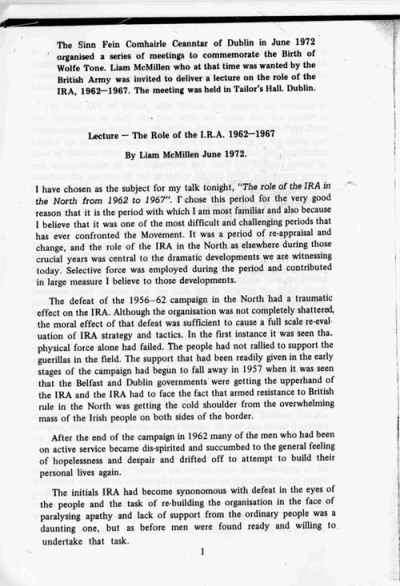
| Date: | June 1972 |
|---|---|
| Organisation: | Sinn Féin [Official] |
| Author: | Liam McMillen |
| View: | View Document |
| Discuss: | Comments on this document |
| Subjects: |
Please note: The Irish Left Archive is provided as a non-commercial historical resource, open to all, and has reproduced this document as an accessible digital reference. Copyright remains with its original authors. If used on other sites, we would appreciate a link back and reference to The Irish Left Archive, in addition to the original creators. For re-publication, commercial, or other uses, please contact the original owners. If documents provided to The Irish Left Archive have been created for or added to other online archives, please inform us so sources can be credited.
Commentary From The Cedar Lounge Revolution
13th October 2008
A very welcome guest post for the Archive today from Brian Hanley. The IRA, 1926 – 1936 is perhaps his best known work amongst a general readership, but for those of us here his forthcoming book co-authored with Scott Millar, on the Official IRA and the Workers’ Party will be of particular interest.
This lecture was delivered by Liam (Billy) McMillen in Dublin during June 1972 at a series of lectures organised by (Official) Sinn Fein to commemorate the birth of Wolfe Tone. As ever the context is important. In 1972 Liam McMillen was one of the best known republicans in Northern Ireland, having been involved in the IRA in Belfast since the early 1950s. From Ton Street, in what is usually called the Lower Falls, his family had been involved in the republican movement since the 1920s. McMillen was first jailed in 1953. For a period during the late 1950s he joined the breakaway Saor Uladh organisation, before returning to the IRA. He was imprisoned again during the IRA’s Border Campaign and on release in 1961 emigrated to England where he worked as a scaffolder. Known as the ‘wee man’ McMillen was a fluent Irish speaker and active in language circles in Belfast. In 1963 he became officer commanding the IRA in that city; after the split in 1969 he was O/C of the Belfast Official IRA and a member of that organisation’s Army Council. When this speech was delivered the Official IRA had just declared a conditional ceasefire, and the North was entering into a period of uncertainity with rumours of a Provisional IRA ceasefire on one hand and increasing sectarian violence on the other. By the time the speech was published in 1975 it would be as part of a tribute to McMillen (Liam MacMaolain: Separatist, Socialist, Republican by D. O’Hagan, 1975), the 48 year old Official IRA leader having been shot dead on April 28th 1975 by the organisation that would become the INLA.
The lecture itself is a brief account of republican politics in the North, particuarly in Belfast from 1962 to the outbreak of the Troubles in 1969. It is a significant document, often overlooked in histories of the IRA and the politics in the 1960s more generally. It certainly provides a different interpretation of many of the well known events of that period and throws new light on some aspects of republican strategy. It begins by describing the aftermath of the Border Campaign and the task the IRA faced in re-building and the realisation, for some at least, that ‘physical force alone had failed.’ McMillen suggests that the early 1960s saw the ‘final surrender by Fianna Fail of the national ideal’ the moves by Sean Lemass to recognise Northern Ireland part of a trend towards telling nationalists to accept partition and ‘settle down to become happy little Britishers.’ That Fianna Fail under Lemass was dragging the South into greater reliance on British imperialism was a central argument for 1960s republicans.
Describing the weakness of the Belfast IRA he nevertheless asserts that their role in ‘upsetting Britain’s plans for Ireland’ would be an important one. McMillen claims that the nationwide commemorations of Wolfe Tone’s birth were the beginning of a re-organisation. He recounts the story of the controversey surrounding the refusal of the then Belfast IRA commander Billy McKee to break an RUC ban on the tricolour at the Wolfe Tone event; in the aftermath of this dispute McKee resigned and was replaced by McMillen. (Bad feeling about this incident simmered and became acute when McKee emerged in late 1969 as a founder of the Provisional IRA in the city). McMillen argues that the ‘tri-colour was to play a central role in the future developments in Belfast, especially in re-awakening the dormont nationalism that slumbered in the hearts of the people.’
In October 1964 McMillen stood as a republican candidate in the Westminister election. As he explains ‘the task of contesting the election fell on the local units of the IRA.’ McMillen recieved 3,256 votes, the best of four republican candidates in the city. He suggests that this proved that ‘abstentionism was dead, and that it was time to bury the corpse.’ (Whether or not he actually thought this in 1964 is hard to say; though the IRA discussed and rejected abandoning abstentionism in 1965.) But the election was notable for the violence which followed the police seizure of a tricoulor from McMillen’s election HQ in Divis Street. Ian Paisley had held several provocative rallies in this period and threatened to march on Divis Street to remove the flag himself if the police did not act. After the RUC smashed their way into the republican HQ there followed was several days of rioting, with the unveiling of new tricolours and the singing of ‘the National Anthem with a solemnity and fervour’ that McMillen claimed never to have witnessed ‘before or since.’ McMillen claims that the events ‘embittered the nationalist population against the Stormont regime (and) set the stage for future confrontations between the youth of the nationalist areas and the RUC.’ The IRA also gained a ‘couple of dozen’ new recruits. For McMillen the events proved that ‘the embers of patriotism still smouldered among the people’ and that ‘a good strong republican breeze was all that was required to fan those embers into flames.’
As for the IRA itself McMillen notes that ‘the routine work of organising a physical force movement continued’ and ‘men were still being recruited, organised into sections, companies and units, and were being trained in the use of arms and explosives.’ McMillen had argued elsewhere that the revolution would have ‘three phases…political agitation, economic resistance and physical force.’ (United Irishman, December 1970). At Easter 1965 in Belfast Sinn Fein president and leading IRA figure Tomas Mac Giolla spoke of the importance of confronting discrimination in the local government franchise. McMillen notes the attempts by the Belfast IRA to establish ‘one-man, one-vote’ committees that year, but that campaign was stillborn, partly according to McMillan because of the ‘intransigence’ of the Northern Ireland Labour Party. However he notes that this effort was in many ways the ‘forerunner’ of the Civil Rights Association. In late 1965 an IRA unit disrupted the showing of British Army recruitment film in a Catholic school in Belfast, (an event McMillen mistakenly dates as happening in 1966). Several Belfast IRA members, including 18-year-old Joe McCann were also jailed that year.
The buildup to the Easter 1966 Anniversary celebrations and the importance the IRA placed on them is also related by McMillen; ‘the whole resources and energy of the Belfast movement were devoted’ to organising the commemorations. They were seen as an opportunity to flout Stormont’s ban on republican symbols. Certainly anyone who believes that militant republicanism was utterly marginal prior to 1969 should look at contemporary coverage of the 1966 commemorations in the North and the large numbers attracted to the Easter events. McMillen mentions two members of the Belfast IRA staff being jailed at this time; he was one of them. This was ‘a small price to pay’ he suggests for the ‘vast return of national fervour’ that accompanied the celebrations. But ominously sectarian tension was also present with clashes when Ian Paisley (again) led a march through the Market area of Belfast in June. McMillen recounts how the local IRA intervened during these riots. He also notes how the newly formed Ulster Volunteer Force had targeted IRA members prior to their killing of Catholic Peter Ward (Contemporary republican sources claim that the UVF had assistance from the RUC Special Branch.)
McMillen was a member of the first executive of the Northern Ireland Civil Rights Association (NICRA) when it was formed in 1967 and helped draw up its constitution. He notes that though the initial meeting was ‘attended in strength’ by members of the Republican movement it was decided not to pack the committee but ensure it was broadly based. (It is worth noting that the presence of the commander of the Belfast IRA on the civil rights executive would hardly have reassured Unionists or the RUC about the organisation’s ‘reformist’ nature). After some months McMillen quietly stepped down and was replaced by Kevin Agnew, a republican from Co. Derry (who would later support the Provisionals). Outside of NICRA activity there were now five Republican Clubs in Belfast though McMillen claims that activists in the city ‘dragged their feet’ in terms of social agitation. He may be slightly exaggerating here. It was only really in Dublin and Derry that the republican movement had prioritized housing agitation during 1967 and Belfast was as active in many ways by 1968 as Cork or other areas. McMillen also notes the IRA’s bomb attacks on British Army recruitment offices in Belfast and Lisburn as part of their ‘happy blend of political agitation and military activity.’ These occurred after the setting up of NICRA (in May 1967 and January 1968) and demonstrate that republican engagement in civil rights did not see the end of armed activity in the North.
McMillen then turns to the republican policy of pushing NICRA to take to the streets, arguing for a march in Belfast during 1968. He does not mention the events in Dungannon which led to the decision to march there but notes that the ‘bulk’ of the Northern IRA were present on August 24th 1968. (In fact of course many were stewards). McMillen perhaps surprisingly describes the march as a ‘disappointing anti-climax.’ He does not recount how the day saw militant speeches from among others Austin Currie and Gerry Fitt who described the RUC as ‘black bastards.’ (While much of the recent coverage has emphasized the influence of the American Civil Rights movement it is worth noting that the marchers in Dungannon sang ‘A Nation Once Again’ as well as ‘We Shall Overcome’ when confronted by RUC lines.)
McMillen then notes the importance of Derry on the 5th of October. Most interestingly he recounts how the IRA had met to discuss their tactics on the day. Again perhaps surprisingly he argues that had the RUC not stopped the march then ‘the CRA would have died a quiet and natural death.’ Instead ‘the events of that day led directly to the dramatic developments’ of 1972. He points to two factors that inspired the RUC’s actions; they had received information that the IRA planned to cause ‘havoc’ in Derry and hence reacted ‘violently to the first gentle nudge’ and secondly that Belfast republicans ‘had been instructed, in the event of the parade being halted by police cordons, to push leading Nationalist politicians into the police ranks. This they did to such effect that one became the first casualty…receiving a busted head from a peeler’s baton.’ (Little sympathy there it seems for Gerry Fitt). McMillen describes how ‘the television coverage of the RUC brutality that day exposed the fascist nature of the Orange/Unionist domination and its ruthless denial of elementary democratic rights to a large section of the citizenry.’ McMillen’s use of the term ‘fascist’ might surprise some, though perhaps it is an indication of how little reform republicans really expected from Stormont. After October 5th the movement mushroomed and McMillen is positive about how it developed; ‘it exposed in a manner which no other movement could have done the blatant injustices of the Special Powers Act, gerrymandering and discrimiation.’ McMillen also claims that the Civil Rights movement raised demands on behalf of the ‘poorest class of Protestants.’ (In fact there is little evidence that NICRA devoted much attention to working class Protestants in its 1968-69 heyday. There were rancourous debates within the Civil Rights movement on whether class demands should be raised to attract working class Protestant support. In general republicans argued against raising these demands for fear of splitting the movement; ‘Republicans must be the foremost advocates of unity in the Civil Rights Movement. They must strongly oppose those who call for a split in the Civil Rights Movement in the spurious belief that in this way that working class Catholics and Protestants will get together for ‘socialist’ and ‘non-sectarian’ demands.’ United Irishman, June 1969). During the winter of 1968 there were several more Civil Rights marches in Derry and one in Armagh (republicans such as Johnnie White in Derry and Denis Cassin were prominent stewards at these events). McMillen briefly mentions the second Derry march. An ominous development in both cities were sectarian clashes after these events.
Then comes January 1969 and Burntollet. McMillen makes no comment on the march, which for some commentators has become a piviotal event. Republican opinion on the march and indeed on the Peoples Democracy organisation itself was divided. Republicans took part in the Belfast to Derry march and provided shelter and food to the marchers. (The United Irishman’s criticism of PD was that they were not sufficently anti-partitionist, not that they were ultra-left). McMillen does not mention the serious rioting in Derry in the march’s wake nor the rioting in Newry a week later when Belfast republicans were again prominent in the disturbances. However he does explain how in April after more rioting in Derry the Belfast IRA burned down 10 post offices in the city to stretch RUC resources. There was also a republican organised march on the Falls Road that ended in large-scale rioting. (The IRA did not claim the fire-bombings at the time, though IRA leader Cathal Goulding publicly warned that ‘if our people in the six counties are oppressed and beaten up…then the IRA will have no alternative but to take military action against the police force [we] have no alternative but to protect our people or allow them to be slaughtered and we are not going to allow them to be slaughtered’ Irish Times, 22 April 1969).
McMillen then notes the various political endeavours of the movement in Belfast, while also estimating IRA membership and arms in the city. Here he praises Joe McCann as one of those who understood the need for both political and miltary activity. (When McMillen gave this lecture McCann was dead, killed by British troops in April 1972). By 1969 the Belfast Housing Action Committee had organised several protests and was squatting homeless families in Divis Towers. McMillen mentions the attempts by republicans to make contact with housing protesters on the Shankhill Road. He then explains that by the summer of 1969 there was increasing pressure on the IRA to respond with weapons to clashes between nationalists and the RUC. Finally he describes the events after the Apprentice Boys march in Derry on August 12th.
Here McMillen, perhaps deliberately, confuses the dates. It was on August 13th that republicans organised demonstrations to tie up RUC resources in Belfast. These led to riots on the Falls Road and it was later that evening that the IRA opened fire on the RUC in Leeson Street. This was one of a number of armed actions carried out under McMillen’s orders on August 13-14th. It was the following day, August 14th that the fighting in west Belfast took on an inter-communal nature. Again McMillen does not go into any detail about the IRA’s role in this, though he asserted in 1970 that ‘the meagre armaments in the hands of the Belfast units were put to their most effective use and, it can be safely said, prevented even more widespread death and destruction’ (United Irishman, December 1970). McMillen himself was arrested on the morning of the 15th in a house off the Falls along with Malachy McGurran (a leading IRA member from Lurgan) and Frank Cards (Proinsias MacAirt, a Belfast IRA member). Interestingly, he asserts, in contrast to much commentary, that during the fighting ‘the people turned to the IRA for leadership and defence’ and that after August the movement ‘enjoyed a popularity among the people it had never experienced before.’ Though centrally involved in the republican split in Belfast McMillen leaves discussion of the formation of the Provisionals to ‘another lecture.’
McMillen’s account is notable for the emphasis it places on reviving nationalist feeling among Belfast Catholics, and for its openness about the role of the IRA in both the Civil Rights movement and in Belfast during 1969. It is particularly important given that recent commentary on the Civil Rights movement has downplayed or ignored altogether republican involvement. It also contrasts very strongly with later claims about republican policy during that period by both historians and some of McMillen’s comrades. There were clearly contradictory influences at work in 1960s republicanism. It was not only the ‘ultra-left’ in the Civil Rights movement who desired confrontation, nor was it only republican ‘traditionalists’ who were interested in armed action. Republicans were in favour of non-violent tactics on occasion but they had not abandoned violence as a strategy; they were after all revolutionaries, commited to the overthrow of both the Northern and Southern states. Cathal Goulding stated publicly in February 1969 that ‘if the civil rights movement fails there will be no answer other than the answer we have always preached. Everyone will realize it and all constitutional methods will go overboard’ (Irish Times, 7 February 1969). I think it is fair to say that in 1969 at least McMillen would have agreed with those sentiments.
More from Sinn Féin [Official]
Sinn Féin [Official] in the archive
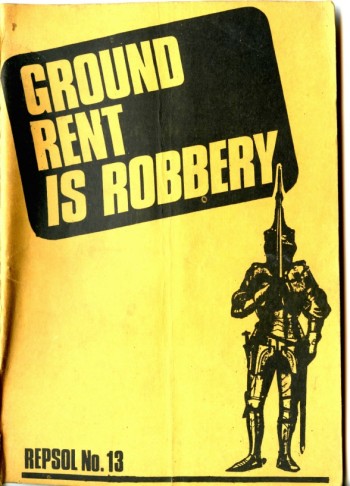
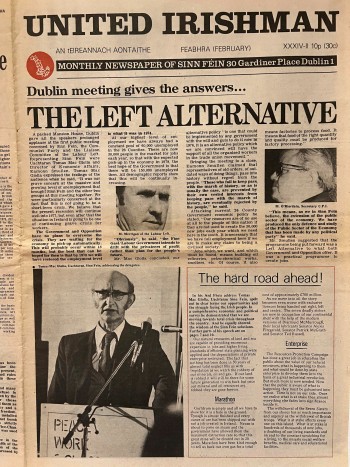
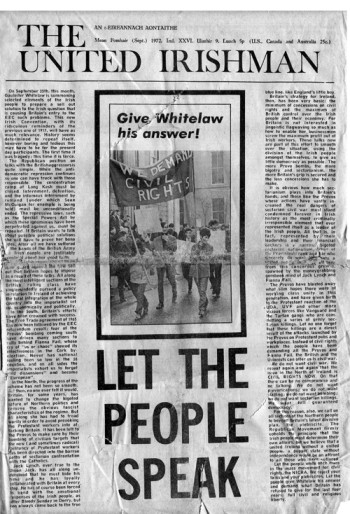
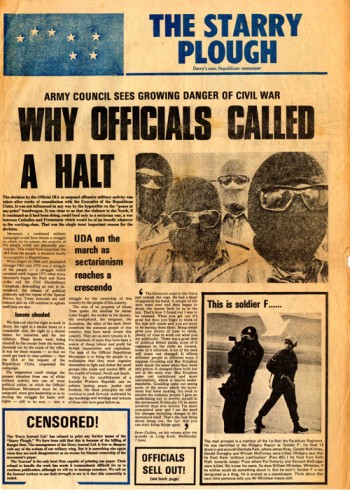
Comments
No Comments yet.
Add a Comment
Comments can be formatted in Markdown format . Use the toolbar to apply the correct syntax to your comment. The basic formats are:
**Bold text**
Bold text
_Italic text_
Italic text
[A link](http://www.example.com)
A link
You can join this discussion on The Cedar Lounge Revolution
By: garibaldy Wed, 15 Oct 2008 21:00:57
I think the comparison drawn was with work in the trade unions, what would now be called community groups, etc, though I would need to check again in those books to confirm it.
Reply on the CLR
By: WorldbyStorm Wed, 15 Oct 2008 21:07:43
Which in a way was what happened eventually. Although typically the party’s enemies were all too happy to run with malign interpretations of it.
Reply on the CLR
By: garibaldy Wed, 15 Oct 2008 21:13:18
Well indeed, this mystique arose about conspiratorial methods and democratic centralism and all the rest. Parodied by John Lowry effectively in 1992 as the notion of waiting for instructions in Russian to seize the GPO.
Reply on the CLR
By: CL Wed, 15 Oct 2008 22:43:58
I’m not exactly saying that the armed struggle was the major stumbling block.Unwinding the historical tape is of course not possible. We don’t know what would have happened in the absence of the armed struggle.
I’m suggesting that an agreement couldn’t have been reached until the futility of the armed struggle was demonstrated. Because there were always those who said that all-out armed struggle could succeed. There was only one way for this argument to be refuted. And so the armed struggle had to occur before it was shown to be in vain-and thus an agreement made possible.
Unionist intransigence I take as a given.
Reply on the CLR
By: garibaldy Wed, 15 Oct 2008 23:03:20
I think there’s an element of truth in what CL says in that the people who were 15 or 20 in 1969 and 1975 had a belief they could succeed. Equally I think that was was waning by the late 1970s until the Hunger Strikes breathed new life into things. The early 1970s saw a series of disasters that alienated large groups from the state; same in the 1980s. I’m not sure it’s an accident that no such event occurred in the early 1990s and the ceasefires were secured.
Reply on the CLR
By: John Harper Mon, 01 Feb 2016 01:30:03
During the civil rights period the majority of the republician movement were working class ,not much education,just saw injustice as injustice,never looked beyond the day,Billy McMillan saw further afield,and,he did his best to educate the members of the offical I.R.A. and the republician clubs that theier strength wad unity within the working class,but as on both sides,the unionist working class were as ignorant as the nationalist working class.I dispair now that the workers party only makes gestures to live up to the ideals of Billy,Cathal and Tomas.
Reply on the CLR
By: Aidso Mon, 29 Oct 2018 13:52:19
Our day will come tiocfaidh a’r l’a
Reply on the CLR